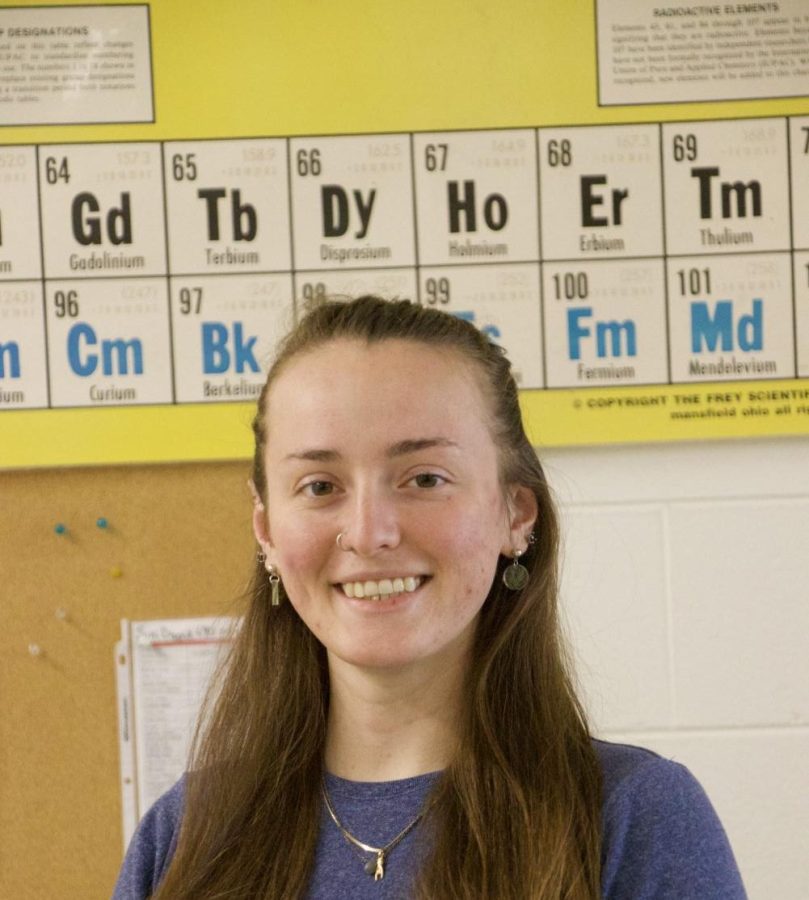New teacher compares classroom to kombucha
Miriam Stevanovic
Miriam Stevanovic, a new science teacher this year at both SHS and SIS, is excited for a year of connecting with students. Stevanovic was born in Sun Prairie, Madison, then moved to Hartford, where she graduated from Hartford Union High School. She then went to Macalester College in St. Paul, Minnesota.
Stevanovic has taught 6th, 7th and 8th grade science, robotics and environmental education. This year, she is teaching 8th–11th grade science. Stevanovic’s inspiration for teaching came when she saw an advertisement for a model engine as a child.
“You could see all the internal mechanisms on the inside, and you could crank it and it would run,” said Stevanovic. “I was fascinated by all the moving parts, and I was like ‘this is happening in every single car’s engine. This is incredible. Machinery is dope, this is the coolest thing I’ve ever seen.’”
Another source of inspiration was Mark Arnold, Stevanovic’s teacher for a biomedical engineering class in her freshman year of college. He had a uniquely immersive teaching style and an inspiring personality.
“He’s just a super goofy, lovable, eccentric dweeb for lack of a better term. But really competent, super supportive, and just a cool dude all around. It was like, ‘I want to be him when I grow up.’”
Last year, Stevanovic was looking for a change. She had researched Shorewood in the past, and, after moving back to Milwaukee, wanted to reconnect with the district. She was drawn to Shorewood’s values of inclusion and equity.
“We’re part of the first year of teachers that are getting more engrossed in all of the equity questions. And in the interview process I was like, ‘oh yeah, these questions are spot on.’ I love it, and I am here for a lot of the things Shorewood stands for.”
One particular question that stood out to her was about how she planned to make her classroom comfortable and welcoming to all students. This is a key issue to Stevanovic, who will do whatever it takes to make sure her students feel welcome in her classroom.
“Science is fun, or it can be fun. It’s fun if it’s safe in chemical matters, and also personal matters, because I can’t learn when I’m hungry, or scared, or I don’t want to be here, or I’m too tired. If those things occur, fun and getting to grow and do cool things does not happen. It’s like trying to dance with too-small shoes. You gotta lose the shoes.”
She also understands that students may not be able to be fully focused on science every day.
“I want you to be here, and you don’t need to be here 100 percent all of the time, especially at like eight in the morning, but at least give it a try.”
Stevanovic likens her classes to the making of a batch of kombucha, a process in which live bacteria are carefully grown and combined over time and made into a drink. When students connect the dots or understand a scientific topic, it’s like finishing the batch.
“It’s cool to see how it all comes together and makes the final product. And that’s what I like to see science as. Flavorful, it’s got some bubbles, there’s a chemical reaction, there’s some stuff growing, it’s delicious, and then, also, kombucha is not for everybody, and that’s okay.”
Stevanovic’s primary goal is to find ways to get her students interested in science, and she has a few strategies to do so. Firstly, she will look to get to know her students and their passions, and then find ways to connect those passions to science. Another strategy is what she calls “the over-pouring love effect.” The idea is that if her students see how passionate she is for science, and how fun it can be, they will be more likely to take interest in it.
“You can see that this is exciting, this is not just science, this is actually fun… [my students] see that someone loves it desperately, like breathing air.”
In the past two months of teaching at Shorewood, Stevanovic has been the most gratified by the progression of her students.
“Big successes: the moments where students get it… making a little bit of progress, whether it’s getting the hang of things, getting this assignment done, feeling more comfortable with the material. Almost like if science was a person, my students are getting to know that person a little more every day.”
Stevanovic looks forward to getting to know her students better over the course of the year.
“When we get to research projects, or things that we do that you’re allowed to infuse some of your own imagination into, I’m looking forward to it. It’s gonna be super cool. Contribute to the kombucha.”

